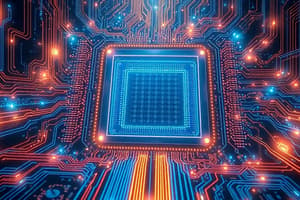Podcast
Questions and Answers
Which of the following is the primary way pipelining improves CPU performance?
Which of the following is the primary way pipelining improves CPU performance?
- By reducing the number of instructions needed to complete a task.
- By using more advanced and expensive hardware components.
- By increasing the clock speed of individual instructions.
- By executing multiple instructions concurrently through overlapping stages. (correct)
In a pipelined processor, what is the role of interface registers (latches) between stages?
In a pipelined processor, what is the role of interface registers (latches) between stages?
- To directly execute instructions and write results to memory.
- To store intermediate results and synchronize data flow between stages. (correct)
- To decode instructions and prepare them for execution.
- To manage and schedule instructions for optimal performance.
What does a space-time diagram primarily illustrate in the context of processor pipelining?
What does a space-time diagram primarily illustrate in the context of processor pipelining?
- The power consumption of different instructions.
- The complexity of the instruction set architecture.
- The physical layout of the processor's components.
- How instructions are executed in real-time across different pipeline stages. (correct)
How does pipelined execution differ from non-pipelined execution in terms of instruction processing?
How does pipelined execution differ from non-pipelined execution in terms of instruction processing?
In a 5-stage RISC pipeline, what is the significance of dividing the instruction execution into stages?
In a 5-stage RISC pipeline, what is the significance of dividing the instruction execution into stages?
Flashcards
Pipelining
Pipelining
Enhances CPU performance by arranging hardware to execute multiple instructions simultaneously.
Overlapping Execution
Overlapping Execution
Executing multiple instructions concurrently in different stages to improve performance.
Stages (or Segments)
Stages (or Segments)
Divide the process into steps, allowing for parallel execution in a pipeline.
Space-Time Diagram
Space-Time Diagram
Signup and view all the flashcards
Interface Registers (Latches)
Interface Registers (Latches)
Signup and view all the flashcards
Study Notes
- Pipelining enhances CPU performance through hardware arrangement.
- It involves arranging existing hardware, not purchasing new components.
- Pipelining increases performance by executing multiple instructions simultaneously through overlapping.
Overlapping Execution
- Overlapping means multiple instructions execute concurrently on different stages.
- Non-pipelined execution involves completing one process before starting the next, which decreases performance.
- In pipelining, processes run on different stages concurrently.
Stages or Segments
- Stages (or segments) divide the process into steps, allowing parallel execution.
- Without stages, a new process can only start after the previous one finishes.
- With multiple stages, different processes run on different stages at the same time.
- This set up gives the impression of multiple processes executing simultaneously, which increases performance.
RISC Pipeline Example
- Reduced Instruction Set Computing (RISC) uses a 5-stage pipeline as example.
- Instructions are executed in these five stages.
Space-Time Diagram
- Space-time diagrams show how instructions are executed in real-time.
- It represents realization, illustrating when multiple instructions are executed.
- Clock cycles are on the X axis, and stages are on the Y axis.
Interface Registers (Latches)
- Interface registers (latches) store intermediate results between stages.
- Output from one stage serves as input for the next stage.
- Registers hold the intermediate output for the next stage's input.
- All devices are connected through a clock to synchronize execution.
- Applying a clock cycle triggers all devices to execute their work.
Performance comparison
- Space-time diagrams illustrate the difference in performance between non-pipelined and pipelined execution.
Studying That Suits You
Use AI to generate personalized quizzes and flashcards to suit your learning preferences.
Description
Pipelining enhances CPU performance by overlapping the execution of multiple instructions. It divides the process into stages, allowing different instructions to run concurrently. This parallel execution gives the impression of simultaneous processing, increasing overall performance.




